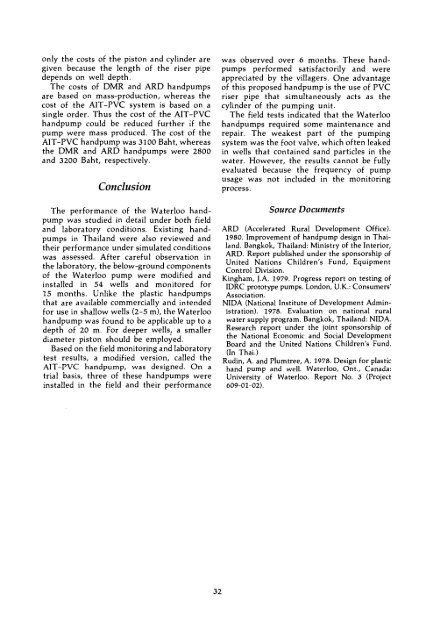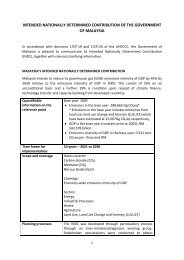RP-01638
RP-01638
RP-01638
You also want an ePaper? Increase the reach of your titles
YUMPU automatically turns print PDFs into web optimized ePapers that Google loves.
only the costs of the piston and cylinder are<br />
given because the length of the riser pipe<br />
depends on well depth.<br />
The costs of DMR and ARD handpumps<br />
are based on mass-production, whereas the<br />
cost of the AIT-PVC system is based on a<br />
single order. Thus the cost of the AIT-PVC<br />
handpump could be reduced further if the<br />
pump were mass produced. The cost of the<br />
AIT-PVC handpump was 3100 Baht, whereas<br />
the DMR and ARD handpumps were 2800<br />
and 3200 Baht, respectively.<br />
Conclusion<br />
The performance of the Waterloo handpump<br />
was studied in detail under both field<br />
and laboratory conditions. Existing handpumps<br />
in Thailand were also reviewed and<br />
their performance under simulated conditions<br />
was assessed. After careful observation in<br />
the laboratory, the below-ground components<br />
of the Waterloo pump were modified and<br />
installed in 54 wells and monitored for<br />
15 months. Unlike the plastic handpumps<br />
that are available commercially and intended<br />
for use in shallow wells (2-5 m), the Waterloo<br />
handpump was found to be applicable up to a<br />
depth of 20 m. For deeper wells, a smaller<br />
diameter piston should be employed.<br />
Based on the field monitoring and laboratory<br />
test results, a modified version, called the<br />
AIT-PVC handpump, was designed. On a<br />
trial basis, three of these handpumps were<br />
installed in the field and their performance<br />
was observed over 6 months. These handpumps<br />
performed satisfactorily and were<br />
appreciated by the villagers. One advantage<br />
of this proposed handpump is the use of PVC<br />
riser pipe that simultaneously acts as the<br />
cylinder of the pumping unit.<br />
The field tests indicated that the Waterloo<br />
handpumps required some maintenance and<br />
repair. The weakest part of the pumping<br />
system was the foot valve, which often leaked<br />
in wells that contained sand particles in the<br />
water. However, the results cannot be fully<br />
evaluated because the frequency of pump<br />
usage was not included in the monitoring<br />
process.<br />
Source Documents<br />
ARD (Accelerated Rural Development Office).<br />
1980. Improvement of handpump design in Thailand.<br />
Bangkok, Thailand: Ministry of the Interior,<br />
ARD. Report published under the sponsorship of<br />
United Nations Children's Fund, Equipment<br />
Control Division.<br />
Kingham, J.A. 1979. Progress report on testing of<br />
IDRC prototype pumps. London, U.K.: Consumers'<br />
Association.<br />
NIDA (National Institute of Development Administration).<br />
1978. Evaluation on national rural<br />
water supply program. Bangkok, Thailand: NIDA.<br />
Research report under the joint sponsorship of<br />
the National Economic and Social Development<br />
Board and the United Nations Children's Fund.<br />
(In Thai.)<br />
Rudin, A. and Plumtree, A. 1978. Design for plastic<br />
hand pump and well. Waterloo, Ont., Canada:<br />
University of Waterloo. Report No. 3 (Project<br />
609-01-02).<br />
32



